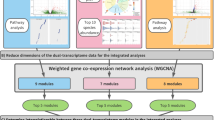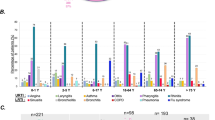Abstract
Background
Although rhinovirus infection is associated with increased risks of acute and chronic respiratory outcomes during childhood compared with respiratory syncytial virus (RSV), the underlying mechanisms remain unclear. We aimed to determine the differences in nasal airway microRNA profiles and their downstream effects between infants with rhinovirus and RSV bronchiolitis.
Methods
As part of a multicenter cohort study of infants hospitalized for bronchiolitis, we examined nasal samples obtained from 16 infants with rhinovirus and 16 infants with RSV. We tested nasal airway samples using microarrays to profile global microRNA expression and determine the predicted regulation of targeted transcripts. We also measured gene expression and cytokines for NFκB pathway components.
Results
Between the virus groups, 386 microRNAs were differentially expressed (false discovery rate (FDR)<0.05). In infants with rhinovirus, the NFκB pathway was highly ranked as a predicted target for these differentially expressed microRNAs compared with RSV. Pathway analysis using measured mRNA expression data validated that rhinovirus infection had upregulation of NFκB family (RelA and NFκB2) and downregulation of inhibitor κB family. Infants with rhinovirus had higher levels of NFκB-induced type-2 cytokines (IL-10 and IL-13; FDR<0.01).
Conclusion
In infants with bronchiolitis, rhinovirus and RSV infections had different nasal airway microRNA profiles associated with NFκB signaling.
Similar content being viewed by others
Log in or create a free account to read this content
Gain free access to this article, as well as selected content from this journal and more on nature.com
or
References
Hasegawa K, Tsugawa Y, Brown DF, Mansbach JM, Camargo CA Jr . Trends in bronchiolitis hospitalizations in the United States, 2000-2009. Pediatrics 2013;132:28–36.
Hasegawa K, Mansbach JM, Camargo CA Jr . Infectious pathogens and bronchiolitis outcomes. Expert Rev Anti Infect Ther 2014;12:817–828.
Mejias A, Dimo B, Suarez NM et al. Whole blood gene expression profiles to assess pathogenesis and disease severity in infants with respiratory syncytial virus infection. PLoS Med 2013;10:e1001549.
Hasegawa K, Dumas O, Hartert TV, Camargo CA Jr . Advancing our understanding of infant bronchiolitis through phenotyping and endotyping: clinical and molecular approaches. Exp Rev Respir Med 2016;10:891–899.
Foster PS, Plank M, Collison A et al. The emerging role of microRNAs in regulating immune and inflammatory responses in the lung. Immunol Rev 2013;253:198–215.
Friedman RC, Farh KK, Burge CB, Bartel DP . Most mammalian mRNAs are conserved targets of microRNAs. Genome Res 2009;19:92–105.
Gutierrez MJ, Gomez JL, Perez GF et al. Airway secretory microRNAome Changes during Rhinovirus Infection in Early Childhood. PLoS One 2016;11:e0162244.
Ilarraza R, Wu Y, Skappak CD, Ajamian F, Proud D, Adamko DJ . Rhinovirus has the unique ability to directly activate human T cells in vitro. J Allergy Clin Immunol 2013;131:395–404.
Papi A, Contoli M, Adcock IM et al. Rhinovirus infection causes steroid resistance in airway epithelium through nuclear factor kappaB and c-Jun N-terminal kinase activation. J Allergy Clin Immunol 2013;132:1075–85 e6.
Bartlett NW, Slater L, Glanville N et al. Defining critical roles for NF-kappaB p65 and type I interferon in innate immunity to rhinovirus. EMBO Mol Med 2012;4:1244–1260.
Hewson CA, Haas JJ, Bartlett NW et al. Rhinovirus induces MUC5AC in a human infection model and in vitro via NF-kappaB and EGFR pathways. Eur Respir J 2010;36:1425–1435.
Girkin J, Hatchwell L, Foster P et al. CCL7 and IRF-7 mediate hallmark inflammatory and IFN responses following rhinovirus 1B infection. J Immunol 2015;194:4924–4930.
Hasegawa K, Mansbach JM, Ajami NJ et al. Association of nasopharyngeal microbiota profiles with bronchiolitis severity in infants hospitalized for bronchiolitis. Eur Respir J 2016;48:1329–1339.
Stewart CJ, Mansbach JM, Wong MC et al. Associations of nasopharyngeal metabolome and microbiome with severity among infants with bronchiolitis: a multi-omic analysis. Am J Respir Crit Care Med 2017;196:882–891.
Hasegawa K, Mansbach JM, Ajami NJ et al. Serum cathelicidin, nasopharyngeal microbiota, and disease severity in infants hospitalized with bronchiolitis. J Allergy Clin Immunol 2016;139:1383–1386.e6.
Mansbach JM, Hasegawa K, Henke DM et al. Respiratory syncytial virus and rhinovirus severe bronchiolitis are associated with distinct nasopharyngeal microbiota. J Allergy Clin Immunol 2016;137:1909–13 e4.
Hasegawa K, Mansbach JM, Ajami NJ et al. The relationship between nasopharyngeal CCL5 and microbiota on disease severity among infants with bronchiolitis. Allergy 2017;72:1796–1800.
Ralston SL, Lieberthal AS, Meissner HC et al. American Academy of Pediatrics. Clinical practice guideline: the diagnosis, management, and prevention of bronchiolitis. Pediatrics 2014;134:e1474–e1502.
Poole A, Urbanek C, Eng C et al. Dissecting childhood asthma with nasal transcriptomics distinguishes subphenotypes of disease. J Allergy Clin Immunol 2014;133:670–8e12.
Sridhar S, Schembri F, Zeskind J et al. Smoking-induced gene expression changes in the bronchial airway are reflected in nasal and buccal epithelium. BMC Genomics 2008;9:259.
McDougall CM, Blaylock MG, Douglas JG, Brooker RJ, Helms PJ, Walsh GM . Nasal epithelial cells as surrogates for bronchial epithelial cells in airway inflammation studies. Am J Respir Cell Mol Biol 2008;39:560–568.
Lambert SB, Ware RS, Cook AL et al. Observational research in childhood infectious diseases (ORChID): a dynamic birth cohort study. PLoS One 2013;8:e63871.
Damsker JM, Dillingham BC, Rose MC et al. VBP15, a glucocorticoid analogue, is effective at reducing allergic lung inflammation in mice. PLoS One 2013;8:e63871.
Kerr DM, Harhen B, Okine BN, Egan LJ, Finn DP, Roche M . The monoacylglycerol lipase inhibitor JZL184 attenuates LPS-induced increases in cytokine expression in the rat frontal cortex and plasma: differential mechanisms of action. Br J Pharmacol 2013;169:808–819.
Yagi O, Aoshiba K, Nagai A . Activation of nuclear factor-kappaB in airway epithelial cells in patients with chronic obstructive pulmonary disease. Respiration 2006;73:610–616.
Read MA, Whitley MZ, Williams AJ, Collins T . NF-kappa B and I kappa B alpha: an inducible regulatory system in endothelial activation. J Exp Med 1994;179:503–512.
Jung D, Kim B, Freishtat RJ, Giri M, Hoffman E, Seo J . miRTarVis: an interactive visual analysis tool for microRNA-mRNA expression profile data. BMC Proc. 2015;9 (Suppl 6 Proceedings of the 5th Symposium on Biological Data):S2.
Tu YC, Huang DY, Shiah SG, Wang JS, Lin WW . Regulation of c-Fos gene expression by NF-kappaB: a p65 homodimer binding site in mouse embryonic fibroblasts but not human HEK293 cells. PLoS ONE 2013;8:e84062.
Fujioka S, Niu J, Schmidt C et al. NF-kappaB and AP-1 connection: mechanism of NF-kappaB-dependent regulation of AP-1 activity. Mol Cell Biol 2004;24:7806–7819.
Hinz M, Lemke P, Anagnostopoulos I et al. Nuclear factor kappaB-dependent gene expression profiling of Hodgkin's disease tumor cells, pathogenetic significance, and link to constitutive signal transducer and activator of transcription 5a activity. J Exp Med 2002;196:605–617.
Cao S, Zhang X, Edwards JP, Mosser DM . NF-kappaB1 (p50) homodimers differentially regulate pro- and anti-inflammatory cytokines in macrophages. J Biol Chem 2006;281:26041–26050.
Jartti T, Paul-Anttila M, Lehtinen P et al. Systemic T-helper and T-regulatory cell type cytokine responses in rhinovirus vs. respiratory syncytial virus induced early wheezing: an observational study. Respir Res 2009;10:85.
Thornburg NJ, Hayward SL, Crowe JE Jr . Respiratory syncytial virus regulates human microRNAs by using mechanisms involving beta interferon and NF-kappaB. MBio 2012;3 pii: e00220-12.
Inchley CS, Sonerud T, Fjaerli HO, Nakstad B . Nasal mucosal microRNA expression in children with respiratory syncytial virus infection. BMC Infect Dis 2015;15:150.
Zech A, Ayata CK, Pankratz F et al. MicroRNA-155 modulates P2R signaling and Th2 priming of dendritic cells during allergic airway inflammation in mice. Allergy 2015;70:1121–1129.
Okoye IS, Czieso S, Ktistaki E et al. Transcriptomics identified a critical role for Th2 cell-intrinsic miR-155 in mediating allergy and antihelminth immunity. Proc Natl Acad Sci USA 2014;111:E3081–E3090.
Martinez-Nunez RT, Louafi F, Sanchez-Elsner T . The interleukin 13 (IL-13) pathway in human macrophages is modulated by microRNA-155 via direct targeting of interleukin 13 receptor alpha1 (IL13Ralpha1). J Biol Chem. 2011;286:1786–1794.
Malmhall C, Alawieh S, Lu Y et al. MicroRNA-155 is essential for T(H)2-mediated allergen-induced eosinophilic inflammation in the lung. J Allergy Clin Immunol 2014;133:1429–38,38 e1-7.
Tully JE, Hoffman SM, Lahue KG et al. Epithelial NF-kappaB orchestrates house dust mite-induced airway inflammation, hyperresponsiveness, and fibrotic remodeling. J Immunol 2013;191:5811–5821.
Ather JL, Hodgkins SR, Janssen-Heininger YM, Poynter ME . Airway epithelial NF-kappaB activation promotes allergic sensitization to an innocuous inhaled antigen. Am J Respir Cell Mol Biol 2011;44:631–638.
Hart LA, Krishnan VL, Adcock IM, Barnes PJ, Chung KF . Activation and localization of transcription factor, nuclear factor-kappaB, in asthma. Am J Respir Crit Care Med 1998;158 (5 Pt 1): 1585–1592.
Gagliardo R, Chanez P, Mathieu M et al. Persistent activation of nuclear factor-kappaB signaling pathway in severe uncontrolled asthma. Am J Respir Crit Care Med. 2003;168:1190–1198.
Panganiban RP, Wang Y, Howrylak J et al. Circulating microRNAs as biomarkers in patients with allergic rhinitis and asthma. J Allergy Clin Immunol 2016;137:1423–1432.
Mosser AG, Vrtis R, Burchell L et al. Quantitative and qualitative analysis of rhinovirus infection in bronchial tissues. Am J Respir Crit Care Med. 2005;171:645–651.
Acknowledgements
We thank Ashley Sullivan, Courtney Tierney, and Janice Espinola at the EMNet Coordinating Center (Massachusetts General Hospital, Boston, MA), and all of the site investigators and study staff for their valuable contributions to the MARC-35 study. We also thank Alkis Togias at the National Institutes of Health (Bethesda, MD) for helpful comments about the study results. Lastly, we thank the participating families for making all of this possible.
Author information
Authors and Affiliations
Corresponding author
Ethics declarations
Competing interests
J.M.M. has provided bronchiolitis-related consultation for Regeneron. P.A.P. received research grants from Gilead, Janssen Vaccines and Prevention, Novavax, and Regeneron, and provided bronchiolitis-related consultation for Ablynx, LFB, MedImmune, Novavax, and Regeneron. All the remaining authors declare no conflict of interest.
Additional information
STATEMENT OF FINANCIAL SUPPORT
This study was supported by the grants UG3 OD-023253, U01 AI-087881, R01 AI-114552, R01 AI-108588, R01 AI-127507, R21 HL-129909, and K12 HL-119994 from the National Institutes of Health (Bethesda, MD).
Disclaimer
The content of this manuscript is solely the responsibility of the authors and does not necessarily represent the official views of the National Institutes of Health.
Supplementary material is linked to the online version of the paper at
Supplementary information
Rights and permissions
About this article
Cite this article
Hasegawa, K., Pérez-Losada, M., Hoptay, C. et al. RSV vs. rhinovirus bronchiolitis: difference in nasal airway microRNA profiles and NFκB signaling. Pediatr Res 83, 606–614 (2018). https://doi.org/10.1038/pr.2017.309
Received:
Accepted:
Published:
Issue date:
DOI: https://doi.org/10.1038/pr.2017.309
This article is cited by
-
Wheezing on admission: a marker for bronchiolitis severity and asthma development
Pediatric Research (2025)
-
Diagnostic value of cytokines in severe childhood Mycoplasma pneumoniae pneumonia combined with Adenovirus infection
Italian Journal of Pediatrics (2024)
-
Epigenetic regulation of pediatric and neonatal immune responses
Pediatric Research (2022)
-
In infants with severe bronchiolitis: dual-transcriptomic profiling of nasopharyngeal microbiome and host response
Pediatric Research (2020)



